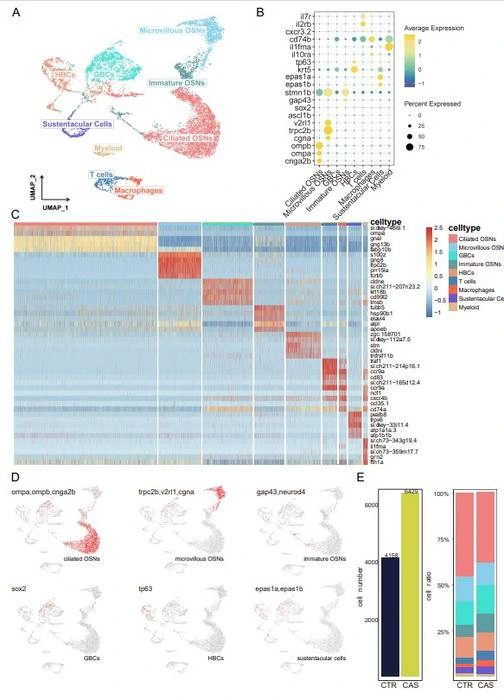
View pictures in App save up to 80% data.
Recent research has revealed significant new findings about the cellular structure and functional processes of the zebrafish olfactory epithelium, utilizing cutting-edge single-cell RNA sequencing technology. This advanced genomic technique offers an unparalleled view into the complex architecture and molecular characteristics of individual cell types within the zebrafish's olfactory system, a species renowned for its remarkable sense of smell. Led by a distinguished group of scientists from China, the study highlights the cellular variety present in the olfactory epithelium, identifying nine unique cell types that each play specialized roles in the chemical detection linked to zebrafish behavior.
Zebrafish, known scientifically as Danio rerio, are widely recognized as key model organisms in the fields of neurobiology and behavioral studies. Their advanced olfactory system is vital for mediating essential survival behaviors such as feeding, selecting mates, and evading predators. In their study, researchers set up a control group alongside a group exposed to conspecific alarm substances (CAS)—chemical signals emitted by injured fish that elicit a startle reaction in others. This targeted approach enabled the researchers to explore the potential adaptability of cell populations within the olfactory epithelium when faced with environmental stressors.
By employing single-cell sequencing techniques, the researchers were able to delineate a range of cell types within the olfactory epithelium of zebrafish, which included both immature and mature olfactory sensory neurons (OSNs), horizontal basal cells, and sustentacular cells. Furthermore, they identified immune cells such as lymphocytes and myeloid cells that exhibit critical immune signaling, highlighting the relationship between the sense of smell and immune function. The research team conducted an advanced clustering analysis that unveiled unique transcriptional profiles for each cell type, showcasing a significant degree of cellular diversity that had not been thoroughly investigated before.
A particularly significant element of the research focused on assessing how CAS influences transcriptional dynamics in the olfactory epithelium of zebrafish. Subsequent analyses revealed marked alterations in the ratios of different cell types and certain populations of olfactory sensory neurons (OSNs). The lead author, Wenjun Chen, expressed that the study's results indicate that CAS exposure may trigger apoptosis in OSNs, leading to a reduction in their overall numbers. This reduction initiates a compensatory response, activating OSN progenitor cells to restore the diminished sensory neuron population, thereby underscoring the adaptability of the olfactory system.
This research broadens our comprehension of how fish cells react to chemical signals, especially when under stress. While earlier studies suggested that teleost fishes harbor various cell types, this investigation offers a more precise and comprehensive view. The importance of this work extends beyond simply identifying different cell types; it also demonstrates how these cellular populations adaptively respond to environmental stimuli, which could have significant repercussions for our understanding of sensory biology and ecological dynamics.
Additionally, the results reveal promising directions for future investigations into the genetic and functional characteristics of these cell types in different environmental and ecological contexts. This underscores the necessity of examining not just the cellular makeup of ecological systems such as zebrafish, but also the dynamic interactions of these cells in reaction to both internal and external factors. Such a holistic perspective allows researchers to broaden their studies to encompass wider ecological and evolutionary frameworks.
Within the realms of conservation biology and environmental sustainability, exploring olfactory plasticity in reaction to chemical signals holds significant importance. This understanding can shed light on how fish populations adjust to alterations in their environments, especially when pollutants or other stressors disrupt standard chemical communication pathways. The zebrafish model serves as an excellent basis for deeper research into these critical matters, providing essential knowledge that could lead to practical ecological solutions in the real world.
In conclusion, the research led by Wenjun Chen and his team marks a notable advancement in the realm of cellular biology, especially concerning sensory systems. The utilization of precision single-cell sequencing technology has transformed our capacity to analyze the complex molecular mechanisms governing cellular interactions in the zebrafish olfactory system. These comprehensive insights into cellular operations may pave the way for future biomedical innovations, potentially steering regenerative medicine approaches and therapeutic solutions aimed at addressing olfactory impairments.
As researchers delve deeper into the intricacies of sensory biology using advanced methodologies, the zebrafish model emerges as an essential resource for comprehending both fundamental biological concepts and the practical dimensions of fisheries science and environmental health. The significance of these discoveries reaches far beyond the confines of academic research and laboratory experiments, influencing conservation projects and ecosystem management strategies that strive to maintain biodiversity in aquatic habitats.
To sum up, the progress demonstrated in this study emphasizes the integration of technology and biology in unraveling the intricate workings of sensory systems and their adaptive mechanisms. The continuous investigation of the zebrafish olfactory epithelium stands out as an intriguing example, showcasing how model organisms can provide valuable insights into wide-ranging biological inquiries that hold importance for society.
Subject of Research: Animals
Article Title: Single-cell RNA sequencing of zebrafish olfactory epithelium reveals cellular heterogeneity and responses to a conspecific alarm substance
News Publication Date: October 2023
Web References: DOI link
References: Scientific Journal Article
Image Credits: Wenjun Chen, et al
Keywords: Bioinformatics, Developmental biology, Genetics, Freshwater biology, Organismal biology
Explore additional insights from the world of Science.
Sign up to receive the newest updates directly in your inbox.